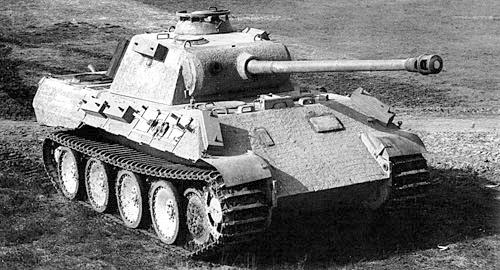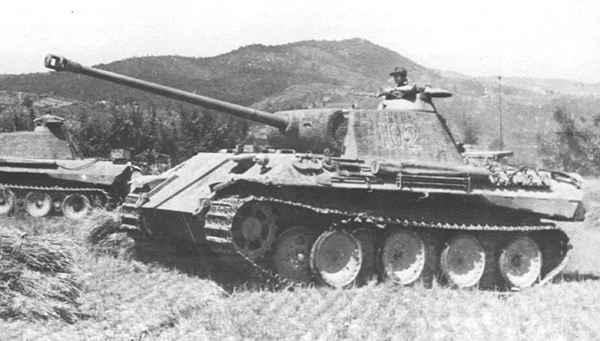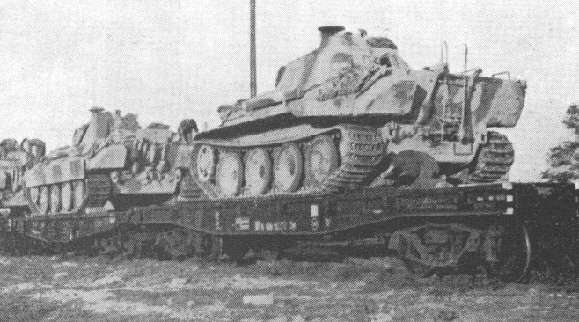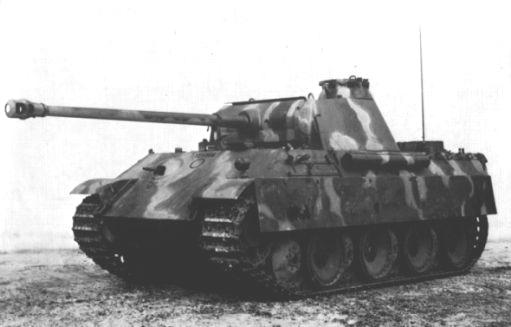Panther Tank Panzerkampfwagen V Panther Sd. Kfz. 171
|
|||||||||||||||||||||||||||||||||||||||||||||||||||||||||||||||||||||||||||||||||||||||||||||||||||||||||||||||||||||||||||||||||
 |
| turret. |
The engines for the ....
|
From July to September 1942, MAN
produced two prototypes, only one of which was fitted with
a turret. These were extensively tested and proved prone
to many technical problems. At the same time, a first order
for 1,000 tanks was placed, with the first tank expected
in early 1943. In late 1942, a small pre-production series
of 20 tanks was ordered. This was the Null-Serie, or Zero
Series. Those 20 tanks were designated Panzerkampfwagen
V Panther Ausfuehrung A and were technically different from
later Ausf A production models. All were lightly armored
(with 60mm frontal armor) and armed with the early version
of the 75mm KwK 42 L/70 gun. This gun had a single-chamber
muzzle brake from the 75mm KwK 40 L/43 gun and was mounted
in a turret that featured a drum cupola that bulged the
turret on the left side. A 650hp Maybach HL 210 P 45 engine
of 21 liters (1,280 cubic inches] displacement powered them.
Interesting conversion was Ausf D1 (some sources state that
it was an early model Bergepanther) fitted with bolted on
PzKpfw IV Ausf H's turret (that could not be traversed),
which served as a command tank of schwere Heeres Panzerjager
Abteilung 653 on the Eastern Front in early/mid of 1944.
The same unit used other early model Bergepanther that was
mounted with 20mm Flakvierling anti-aircraft gun and Flakpanzer
T-34(r).
| Combat Service |
In December 1942, a new and improved model, designated Ausf D, was ready. In February 1943, 20 Ausf A tanks were re-designated Ausf D1. These Ausf D1 models were exclusively used as test vehicles and later for training. By this time, preparations were under way for Operation "Zitadelle" (Citadel). For this, the Army ordered 250 Panthers to be ready by May 12, 1943, while 750 more were to be completed as soon as possible. In December 1942, Ausf D entered production, and the first D model left the factory on January 11, 1943. Armor protection was improved (in comparison to Ausf D1) and the newer version of the 75mm KwK 42 L/70 gun was mounted in a hydraulically-powered turret. The first 250 Panther Ausf D tanks were powered by a Maybach HL 210 P 30 [with 23 liters (1,400 cubic inches) displacement] and were also referenced as Ausf D1. The Panther's weak spot was its side armor, which ranged from 40mm to 50mm, depending on the variant.
Panzerkampfwagen V Panther Ausf D(D1), along with Panzerjäger
Tiger(P) Ferdinand (Sd.Kfz.184) and other new armored fighting
vehicles, made their debut with Panzer Abteilungen 51 and
52 (96 tanks each) along with Panzer Regiment Stab 39 (8
tanks each) as part of Heeresgruppe Sued (Army Group South)
in July 1943 during Operation Citadel in the Kursk salient.
Because of technical problems (especially with the gearbox,
transmission and suspension, and engine fires) that were
not fully solved until later, many Panthers broke down before
and during the battle.
 |
|
| Tank |
Specifications
From the original 250 Panthers, only 43 were in service
by August 10, 1943. These were later converted to Panzerbefehlswagen
(Sd.Kfz.267). The next 600 Ausf D (also called Ausf D2)
were powered by a more powerful 700hp HL 230 P 30 engine,
which became the standard power plant for all later models
of the Panther. They also featured a cast commander's
cupola instead of the early drum-type cupola, and armor
skirts, which were standard on later Ausf D Panthers and
all later models. Ausf D also equipped 23rd and 26th Independent
Panzer Regiment as well as Panzer Regiment of Das Reich
and Leibstandarte SS Adolf Hitler Panzer Divisions. In
general, from December 1942 to September 1943, some 850
were produced by MAN, Daimler-Benz, MNH and Henschel.
In August 1943, after repairs and modifications to the gearbox and other systems, a new variant of Panther was produced-the Ausf A, which soon became a formidable weapon. Panther Ausf A was the most numerous variant during the Normandy campaign, and some 400 Panthers of all types were lost there. Panther Ausf A featured a redesigned turret, the new cast commander's cupola, a mounting bracket for an AA MG34 on the cupola, a ball-mounted MG34 in the frontal plate and standard armor skirts. Over time, five different types of exhaust arrangement were used. In general, from August 1943 to May 1944, some 2,200 were produced by MAN, Daimler-Benz, Demag and Henschel.
As with any weapon in constant use, various modifications
and design changes were made to the Panther to improve
its combat capabilities. In March 1944, the first Ausf
G was produced. Panther Ausf G became the most numerous
model, and had many new features. These included a new
design for the top hull hatches, removal of the driver's
visor in the glacis (front) plate and upper hull sides
closer to the vertical. Later variants had a rotating
periscope for the driver, a new exhaust arrangement, a
new mantlet design to eliminate the shot trap and a new
engine deck layout with a raised fan cover. Perhaps the
most distinctive feature of the Ausf G was the tapered
one-piece upper hull side plate on the sponson over the
suspension. From March 1944 to April 1945, some 2,950
were produced by MAN, Daimler-Benz and MNH.
Older models returned for repairs were often fitted with
newer parts creating hybrids.
Overall, from 1943 to 1945, only some 6000 Panthers were produced by Maschinenfabrik-Augsburg-Nuremberg (MAN) in Kassel and Maschinenfabrik Niedersachsen-Hannover (MNH) in Hannover, along with Daimler-Benz, Henschel and Demag
.
Specifications Ausf D
Weight:
43000kg
Crew:
5 men
Engine:
Maybach HL 230 P 30 /
12-cylinder / 700hp
Speed:
Road: 46km/h / Cross-Country:
24km/h
Range:
Road: 200km / Cross-Country:
177km
Fuel Capacity:
730 litres
Lenght:
6.88m (w/o the gun)
8.86m (with the gun)
Width:
3.40m
Height:
2.98m
Armament:
75mm KwK 42 L/70 & 2 x
MG
(1 x MG34 - hull)
(1 x MG34 - coaxial)
Ammo:
75mm - 79 rounds
7.92mm - 5100 rounds
Armor (mm/angle):
Front Turret: 100/10
Front Upper Hull: 80/55
Front Lower Hull: 60/55
Side Turret: 45/25
Side Upper Hull: 40/40
Side Lower Hull: 40/0
Rear Turret: 45/25
Rear Lower Hull: 40/30
Turret Top / Bottom: 16/83 / 16/90
Upper Hull Top / Bottom: 16/90
Lower Hull Top / Bottom: 30/90 / 16/90
Gun Mantlet: 100/round

Specifications Ausf G
Weight:
45500kg
Crew:
5 men
Engine:
Maybach HL 230 P 30
/ 12-cylinder / 700hp
Speed:
Road: 46km/h / Cross-Country:
24km/h
Range:
Road: 200km / Cross-Country:
177km
Fuel Capacity:
730 litres
Lenght:
6.88m (w/o the gun)
8.86m (with the gun)
Width:
3.40m
Height:
2.98m
Armament:
75mm KwK 42 L/70 & 3
x MG
(1 x MG34 - hull)
(1 x MG34 - coaxial)
(1 x MG42 - cupola)
Ammo:
75mm - 81-85 rounds
7.92mm - 4200-4800 rounds
Armor (mm/angle):
Front Turret: 110/11
Front Upper Hull: 80/55
Front Lower Hull: 60/55
Side Turret: 45/25
Side Upper Hull: 50/30
Side Lower Hull: 40/0
Rear Turret: 45/25
Rear Lower Hull: 40/30
Turret Top / Bottom: 16/84 / 16/90
Upper Hull Top / Bottom: 40/90 / 16/90
Lower Hull Top / Bottom: 30/90 / 16/90
Gun Mantlet: 100/round
Ma

).
table data
Penetration of Armor Plate at 30 degrees from Vertical.
Ammunition:
100m
500m
1000m
1500m
2000m
Panzergranate 39/42
138mm
124mm
111mm
99mm
89mm
Panzergranate 40/42
194mm
174mm
149mm
127mm
106mm
Pzgr.39/42 (APCBC) - Armor Piercing Composite Ballistic Cap
Pzgr.40/42 (APCR) - Armor Piercing Composite Rigid (Tungsten Core)
Specifications Ausf D
| Weight: | 43000kg |
| Crew: | 5 men |
| Engine: | Maybach HL 230 P 30 / 12-cylinder / 700hp |
| Speed: | Road: 46km/h / Cross-Country: 24km/h |
| Range: | Road: 200km / Cross-Country: 177km |
| Fuel Capacity: | 730 litres |
| Lenght: | 6.88m (w/o the gun) 8.86m (with the gun) |
| Width: | 3.40m |
| Height: | 2.98m |
| Armament: | 75mm KwK 42 L/70 & 2 x
MG (1 x MG34 - hull) (1 x MG34 - coaxial) |
| Ammo: | 75mm - 79 rounds 7.92mm - 5100 rounds |
| Armor (mm/angle): | Front Turret: 100/10 Front Upper Hull: 80/55 Front Lower Hull: 60/55 Side Turret: 45/25 Side Upper Hull: 40/40 Side Lower Hull: 40/0 Rear Turret: 45/25 Rear Lower Hull: 40/30 Turret Top / Bottom: 16/83 / 16/90 Upper Hull Top / Bottom: 16/90 Lower Hull Top / Bottom: 30/90 / 16/90 Gun Mantlet: 100/round |

|
Specifications Ausf G
| Weight: | 45500kg |
| Crew: | 5 men |
| Engine: | Maybach HL 230 P 30 / 12-cylinder / 700hp |
| Speed: | Road: 46km/h / Cross-Country: 24km/h |
| Range: | Road: 200km / Cross-Country: 177km |
| Fuel Capacity: | 730 litres |
| Lenght: | 6.88m (w/o the gun) 8.86m (with the gun) |
| Width: | 3.40m |
| Height: | 2.98m |
| Armament: | 75mm KwK 42 L/70 & 3
x MG (1 x MG34 - hull) (1 x MG34 - coaxial) (1 x MG42 - cupola) |
| Ammo: | 75mm - 81-85 rounds 7.92mm - 4200-4800 rounds |
| Armor (mm/angle): | Front Turret: 110/11 Front Upper Hull: 80/55 Front Lower Hull: 60/55 Side Turret: 45/25 Side Upper Hull: 50/30 Side Lower Hull: 40/0 Rear Turret: 45/25 Rear Lower Hull: 40/30 Turret Top / Bottom: 16/84 / 16/90 Upper Hull Top / Bottom: 40/90 / 16/90 Lower Hull Top / Bottom: 30/90 / 16/90 Gun Mantlet: 100/round |

|
table data
| Penetration of Armor Plate at 30 degrees from Vertical. | |||||
| Ammunition: | 100m | 500m | 1000m | 1500m | 2000m |
| Panzergranate 39/42 | 138mm | 124mm | 111mm | 99mm | 89mm |
| Panzergranate 40/42 | 194mm | 174mm | 149mm | 127mm | 106mm |
| Pzgr.39/42 (APCBC) - Armor Piercing Composite Ballistic Cap | |||||
| Pzgr.40/42 (APCR) - Armor Piercing Composite Rigid (Tungsten Core) | |||||
Panzerkampfwagen V Panther Photo Gallery
Contact Webmaster
Mike Kaspar
